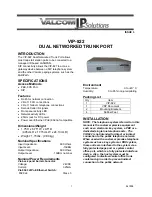
86
C
HAPTER
A: D
YNAMIC
Access T
ECHNOLOGY
S
ERVER
F
EATURES
About Failover
In addition to load balancing, RSLs provide failover fault
tolerance between a server and a switch — if one NIC
in a group fails, the others assume the network load of
the failed NIC. The failover behavior of secondary NICs
depends on how you set load balancing:
■
In a
transmit-only
load balancing arrangement, the
primary NIC is the only one that receives packets. If
the primary NIC fails, a secondary NIC assumes the
configuration profile, network traffic, and active
status of the failed primary NIC.
■
In a
bidirectional
load balancing arrangement, all NICs
receive packets. If any NIC fails, receive load balancing
is disabled, and the other NICs continue transmit-only
load balancing activity. Receive load balancing is
restored when new connections are established
with clients.
If any NIC in a bidirectional arrangement fails, receive
load balancing is disabled, and the other NICs continue
transmit-only load balancing activity. If the primary NIC
failed, a secondary NIC takes over packet reception for
the group.
Figure 27
Bidirectional Load Balancing Failover
Bidirectional load balancing is restored after a failure when
applications create new connections and new clients log in.
®
Server
Bidirectional
load balancing
®
Primary failure
Secondary failure
Clients
®
Primary Secondaries
Primary Secondaries
Primary Secondaries
Switch
Book Page 86 Monday, June 7, 1999 2:14 PM
















































